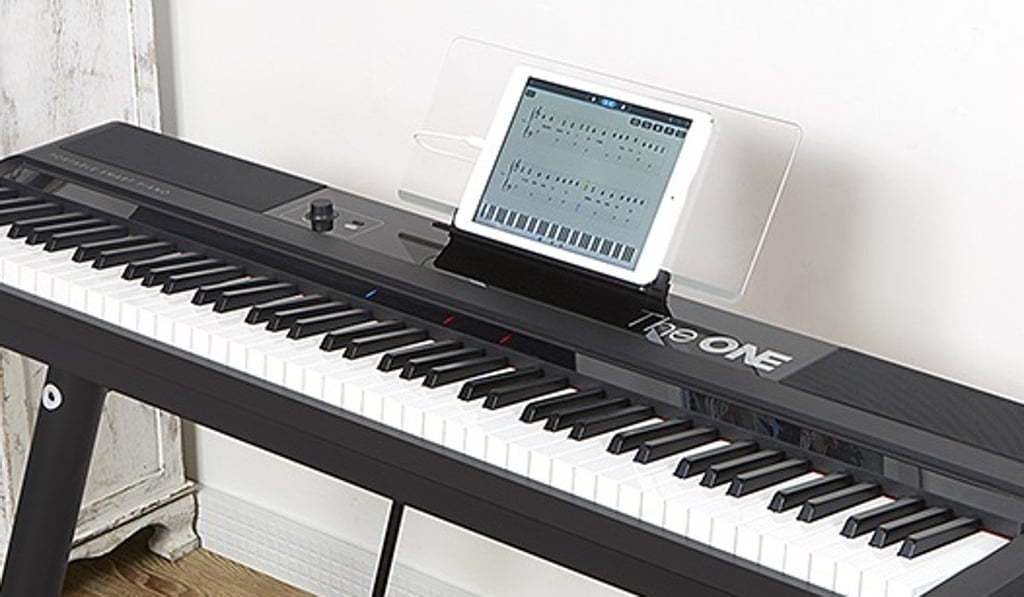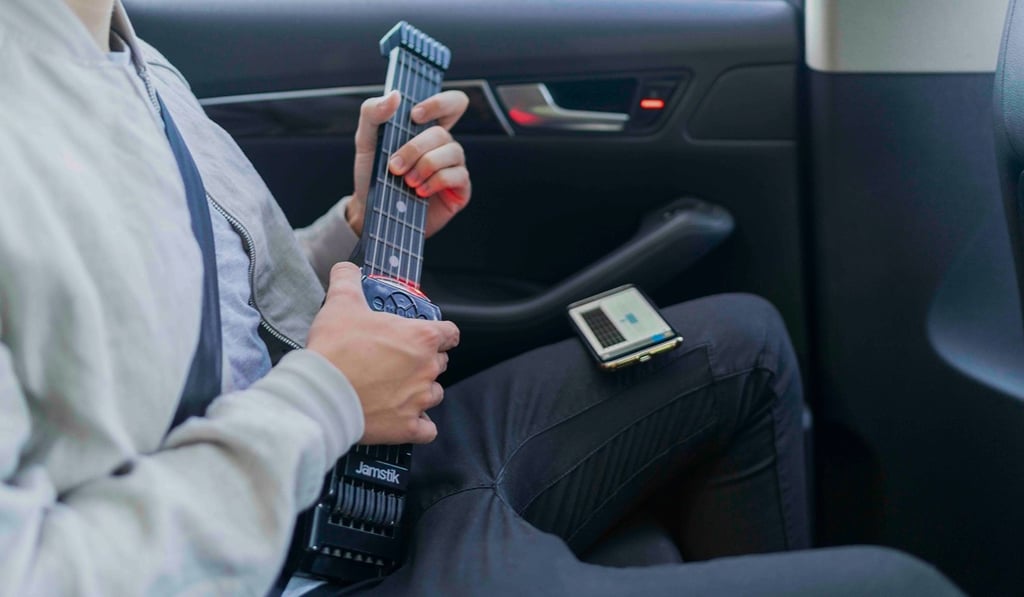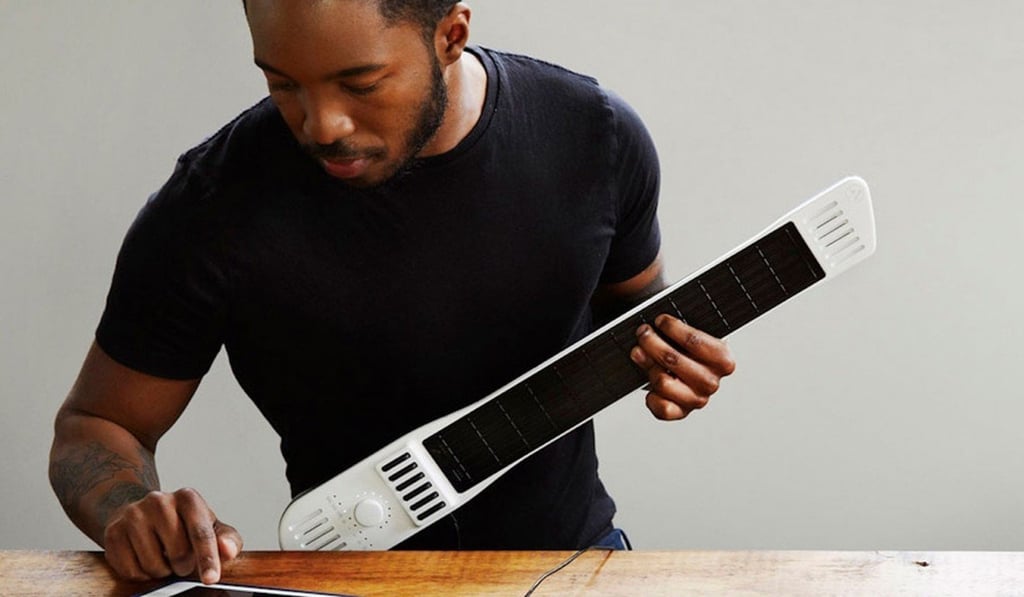Self-taught musicians hit the high notes on app-connected digital keyboards and string instruments
Smart ukuleles, pianos, guitars and other devices linked to phones, tablets and computers, are revolutionising the way we learn and play music

The prolific Austrian composer Wolfgang Amadeus Mozart – a child prodigy as a harpsichordist and pianist – could pick out chords at the age of three and was writing his own music by the time he was five.
For most of us, though, mastering a musical instrument will take many years of dedicated practice.
However, help is at hand, thanks to the latest digital technology, for those people who lack the time and patience – and funds to pay for private tuition – and want to make more rapid progress.
A series of smart instruments are now available, all of which can connect to smartphones, tablets and computers, to help you get started, improve your technique and quickly play some of your favourite music and songs.
‘Illuminated’ ukulele shows the way

The Populele – a Bluetooth and app-enabled 23-inch- (58-centimetre)-long ukulele – uses 72 light-emitting-diodes (LEDs) embedded in the fretboard to help you memorise chords right from the start.
American start-up Popuband Music promises that budding musicians – who dream of being the next Jimi Hendrix, the legendary American rock guitarist who started out playing on a discarded, single-string ukulele – can be strumming along to their first song on the instrument within 15 minutes.
Popuband Music says it developed the Populele in 2017, after investment from the Indiegogo crowdfunding website, because of its “conviction that music education can change lives”.
Private tutors are expensive, and the average person’s schedule isn’t suited to regular classroom attendance. But why a ukulele? For the musically unversed, the ukulele is basically the most approachable instrument out there
It says: “Private tutors are expensive, and the average person’s schedule isn’t suited to regular classroom attendance.
“But why a uke [ukulele]? For the musically unversed, the ukulele is basically the most approachable instrument out there.”
The app, which is compatible with both Android and iOS, helps you fine-tune the ukulele before you start and provides a library of chords, and a playlist of almost 100 songs.
It offers step-by-step, game-based instruction on playing techniques, such as strumming, plucking and chord switching.
“Follow me” LEDs light up on the fretboard to show you the correct fingering positions of the chords, while the app’s note-recognition capabilities mean you get instant feedback on your playing.
When you select a song from the playlist the app will provide a rhythm accompaniment to guide you as you play.
For now, the lightweight instrument, which can be played for up to 10 hours at a time after being charged via a micro USB port, is not suitable for left-handed players – so it would have excluded the late Hendrix.
However, Popuband says a suitable version is in development and should be available next year.
Smart keyboard with ‘bright’ idea

Another US company, The ONE Music Group, offers a range of digital pianos that also feature LEDS.
The instruments connect to an integrated iOS and Android-compatible app, which it says can help “anyone” learn to play the piano within minutes.
Software entrepreneur Ben Ye, CEO and founder, set up the business in 2013 after he built a smart piano prototype for his eight-year-old son, Bob – who had given up private piano lessons soon after starting – and found him playing Twinkle Twinkle Little Star after only 20 minutes.
Ben Ye, founder of The ONE Music Group, built a smart piano prototype and found his son Bob, aged eight, playing ‘Twinkle Twinkle Little Star’ after only 20 minutes
The company says it has now taught more than 200,000 people to play the piano.
Its products include the portable The ONE Smart Keyboard Pro – suitable for users as young as three – which uses the app to connect to a tablet to provide interactive lessons and video games as an alternative to private lessons.
The keyboard has LEDs set above each of its 88 weighted keys, which are illuminated when playing tunes from the app’s LED-guided sheet music.
The company says it regularly updates and adds new features to the app, including new sheet music.
Ye says: “We’ve seen tremendous results from our first few smart piano products, from customers and in educational classrooms, and aim to further the experience … with our new Keyboard Pro.”
‘Unconventional’ Jamstik gets upgrade

The seven-fret and 12-fret updates of the earlier six-string, five-fret Jamstik and Jamstik+ instruments – which are built to the same specifications as a normal guitar – feature fretboard sensors, which detect where your fingers are.
The companion app displays the positions on the screen of your smartphone or tablet, giving you instant feedback, so you know if you are playing the right or wrong notes.
The latest models use not only Jamstik apps, such as JamTutor – an instructional app intended to teach users the basics of guitar with arcade-like games and challenges – but also numerous other apps and compatible software.
The Jamstik 7, with seven frets, is for people who either wish to pick up the guitar for the first time, get reacquainted with playing, or want to practice and play supported by a multitude of software and apps.
The top-of-the-range Jamstik 12, with 12 frets, is aimed at existing guitar players and musicians looking for a serious MIDI-capable instrument for songwriting, music production and performance.
“We intentionally designed the Jamstik 7 to be portable and easy to play anywhere,” Matt Cannon, director of growth at Zivix, says.
“It’s also easy for all ages to handle and perfect for beginners who are just getting started learning to play guitar.”
However, the latest versions of the Jamstik smart guitar also have futuristic capabilities, which make them more than just a guitar, he says.
They are also Musical Instrument Digital Interface (MIDI) controllers, which means, when connected to software, they can create sounds like almost any instrument you can think of.
Swedish sensor-connected smart guitar

It calls the acoustic/electric instrument “the world’s first real smart guitar” and the demonstration video certainly does makes it sound very smart indeed as the guitarist – controlling various motion, touch, distance and pressure sensors on the instrument, including a ribbon sensor along the neck – plays the strings.
The Sensus – made from red spruce, the same wood Antonio Stradivari used in his 18th century violins – is “a wireless digital audio station and true IoT [Internet of Things] device”, the company says.
IoT is the network of physical devices, vehicles, home appliances, and other items that are embedded with electronics, software and sensors which enables them to connect, collect and exchange data.
The guitar’s wooden body can be used to channel an assortment of internal acoustic effects as well as any sound transmitted wirelessly to the guitar.
It can also record the sounds it makes, in studio-level quality, straight from the guitar.
The brand’s innovative music operating system, named ELK, means musicians can add unlimited sounds and features to their instruments and share performances online.
Michele Benincaso, the company’s Italian CEO and founder – also an expert guitar and violin maker – is shown playing the first prototype of the guitar in the video below, where he demonstrates, in order, first the motion, then touch, pressure (drum-like), ribbon, distance and then, lastly, (again) the motion sensor.
Benincaso says the Sensus smart guitar prototype was developed with millennials and contemporary players in mind.
“Our whole life is connected nowadays, and we wanted to understand how musical instruments could evolve in this same direction,” he says.
“Sensus and ELK music operating system are the result of our research.”
MIND Music Labs hopes the Sensus will be regarded as a new type of instrument for accomplished musicians – “like the electric guitar was [once] ‘new’ compared with a classical guitar,” Benincaso says.
The instrument’s tracking technology could also be used as teaching software to help practice and training.
An all-in-one guitar, piano and drum

This slim, rectangular object, with a fingerboard, which resembles the neck of a guitar, is a MIDI controller, which enables you to strum, slide, tap and drum any sound on a single interface.
The INSTRUMENT 1 device, which comes complete with built-in speakers and a headphone jack, has buttons and dials that allow the user to move between instruments and between modes, including Fretted and Strum mode.
The rectangular fingerboard is sensitive to both pressure and velocity and can be adjusted so that, for example, it reacts like a keyboard, guitar strings, harp strings or a drumhead.
It means you can use your existing guitar, bass, or other stringed instrument skills to play any sound imaginable with synths or samples.
It comes with a companion app, which helps you tune your instrument and combine sounds to create your own, new instrument.
While designed for iOS devices, INSTRUMENT 1 is also compatible with other MIDI music-making software, including GarageBand and Ableton.
With additional reporting from Tamsin Bradshaw